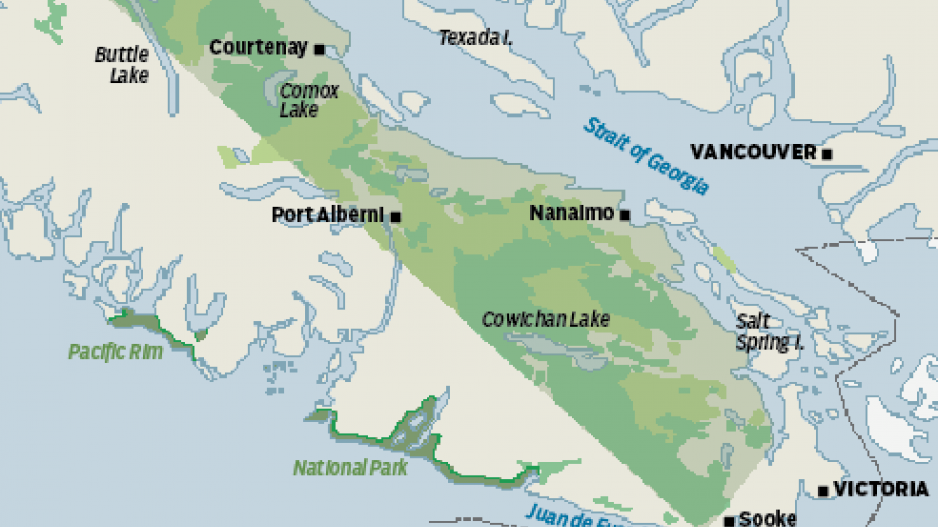Logging companies know all too well that exercising timber-cutting rights anywhere near an urban centre on Vancouver Island can draw pushback from Islanders, many of whom don’t like to see forests clear-cut in what they consider part of their community’s backyard.
That could explain why TimberWest has been pursuing a wide variety of new business ventures.
They include a proposed new $60 million wood pellet plant in Nanaimo, wind and run-of-river energy projects and real estate.
In 2009, TimberWest created Couverdon Real Estate, which is marketing roughly 620 hectares of residential real estate on Vancouver Island, as well as 166 hectares of commercial-industrial land adjacent to Campbell River’s airport.
“Real estate is not our core business, but it is an option to add value to our core business,” said Jan Marston, TimberWest’s vice-president in charge of Couverdon.
Island Timberlands LP also sells some real estate, although not quite on the scale of TimberWest.
“Some are more isolated than others and some may be very close to communities or within communities, and in those cases, managing on the long term for forestry may not be the best fit for the community,” said Island Timberlands spokesperson Morgan Kennah.
Roughly one-sixth of Vancouver Island is owned by TimberWest and Island Timberlands as part of a land grant made to Robert Dunsmuir in the 1880s in exchange for building the E&N Railway.
TimberWest alone owns 325,000 hectares on Vancouver Island (about 11% of the Island’s total area), so the land it currently has up for sale for residential and commercial development is a tiny fraction. But that small fraction constitutes some prime real estate near urban centres such as Campbell River, Nanaimo, Coombs and Ladysmith.
The properties include 53 hectares on the Nanaimo River, where waterfront lots as large as 30 acres (12 hectares), serviced with power and telephone, can be had for $549,000 – about half the price of an average detached house in Vancouver. Just outside of Campbell River, 100-acre lots with the Little Oyster River running through them can be had for as little as $399,000.
Couverdon also has larger residential development proposals for Campbell River and Ladysmith. But as the company recently learned, residential development can be just as tough to sell to Vancouver Islanders as logging.
Gail Adrienne, executive director for the Nanaimo & Area Land Trust, which has its eye on some of Couverdon’s Nanaimo River lots, said some Vancouver Islanders would rather see forests cut than paved.
“Our view is that it’s better to cut it and let it grow back,” she said, adding that TimberWest has done a good job of harvesting carefully and replanting on Vancouver Island.
“Once you’ve paved paradise, it’s pretty much gone. You’ve destroyed the ecosystem and habitat values. Cutting does some of that, too. But … if it’s then protected or converted into sustainable usage, it has the potential over time to go back to something close to what it was.”
TimberWest has proposed moving Ladysmith’s town boundaries to include 273 hectares of forest. About half the land would be developed for residential purposes, in phases over several decades, with the rest being protected as parkland and/or open green spaces.
But in October 2014, Ladysmith town council voted against holding a referendum on the proposal.
One of the sticking points was water. Development on Vancouver Island and the Gulf Islands is constrained by limited drinking water supply. Despite plans to include two TimberWest lakes in Ladysmith’s watershed, the town council voted against putting the TimberWest proposal to a public vote.
Marston said TimberWest has not abandoned its plans and hopes the boundary adjustment will be reconsidered.
Couverdon’s residential development plans have been getting a better reception in Campbell River than in Ladysmith. Its 65-hectare Jubilee Heights development is already in the city’s boundaries and has been included in the city’s official community plan.
“In Campbell River’s case, both the Jubilee Heights as well as the airport lands have been pretty well received by the community and by the city,” said Campbell River deputy city manager Ron Neufeld. “A lot of the low-
hanging fruit, in terms of developable land within our urban residential containment boundary, has been slowly filling up, and the next logical large block of land is the Jubilee Heights area.”
As of last week, Couverdon had sold only seven lots. Vancouver Island’s recreational property market was hit by the 2008 financial crisis in the U.S. Marston said a recovering U.S. economy is expected to improve that market.




